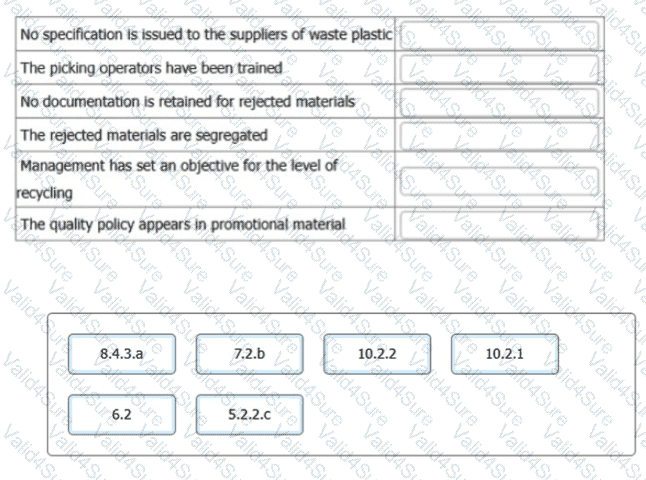ISO-9001-Lead-Auditor Exam Dumps - QMS ISO 9001:2015 Lead Auditor Exam
Searching for workable clues to ace the PECB ISO-9001-Lead-Auditor Exam? You’re on the right place! ExamCert has realistic, trusted and authentic exam prep tools to help you achieve your desired credential. ExamCert’s ISO-9001-Lead-Auditor PDF Study Guide, Testing Engine and Exam Dumps follow a reliable exam preparation strategy, providing you the most relevant and updated study material that is crafted in an easy to learn format of questions and answers. ExamCert’s study tools aim at simplifying all complex and confusing concepts of the exam and introduce you to the real exam scenario and practice it with the help of its testing engine and real exam dumps
You are conducting an ISO 9001 audit of a Materials Recycling Facility. The organisation processes
waste plastics into raw materials for plastic bottle manufacturers. You reach the manual picking line
where operators are removing contaminant materials from incoming products, such as plastic bags,
plastic film and badly contaminated items that would compromise the recycling process. You
interview the line supervisor.
You: "Why are these plastic items being rejected at this stage?"
Auditee: "They do not meet our processing standards."
You: "What is the reason for that?"
Auditee: "These items are likely to damage the machinery down the line. They can also
compromise our quality standards. We need to protect our reputation for good quality output
materials."
You: "What happens to the rejected items?"
Auditee: "Some get melted down in another process later on, and some are disposed of as waste
products that cannot be recycled."
You: "What happens to the waste products?"
Auditee: "I'm not sure. I suppose they go to landfill."
After further auditing, you have gathered additional evidence. Match the following
statements to the correct ISO 9001 standard clause shown.
To complete the table, click on the blank section you want to complete so that it is
highlighted in red, and then click on the applicable text from the options below.
Alternatively, drag and drop each option to the appropriate blank section.

Scenario 2:
Bell is a Canadian food manufacturing company that operates globally. Their main products include nuts, dried fruits, and confections. Bell has always prioritized product quality and has maintained a good reputation for many years. However, the company's production error rate increased significantly, leading to more customer complaints.
To increase efficiency and customer satisfaction, Bell implemented a Quality Management System (QMS) based on ISO 9001. The top management established a QMS implementation team comprising five middle managers from various departments, including Leslie, the quality manager.
Leslie was responsible for assigning responsibilities and authorities for QMS-related roles. He also suggested including a top management representative in the QMS team, but top management declined due to other priorities.
The team defined the QMS scope as:
"The scope of the QMS includes all activities related to food processing."
Leslie established a quality policy and presented it to the team for review before top management approval. Top management also proposed a new strategy for handling customer complaints, requiring biweekly customer surveys to monitor customer perceptions.
In scenario 2, the team determined the QMS scope by taking into account only the requirements of top management. Is this compliant with ISO 9001?
Auditor competence is a combination of knowledge and skills. Which two of the following activities are predominately related to 'knowledge'?
You are carrying out an annual audit at an organisation that has been certificated to ISO 9001 for two years. The organisation offers home security
services. The scope of the quality management system covers alarm installation, alarm servicing, alarm monitoring and response. The business
operates from a single office and employs subcontract installers and service technicians across the country.
You have just completed the opening meeting. You are interviewing the Managing Director (MD).
You: "I would like to gain an understanding of how the quality management system has been supporting your business and its strategic direction."
MD: "We are continuing to face difficult times. The market is extremely competitive, and customers typically look for the least expensive option when
choosing home security services. We have not yet seen any business benefit from our quality management system."
You: "Tell me how you determine external and internal issues."
MD: "We use SWOT analysis (Strengths Weaknesses, Opportunities, Threats)."
You: "How have the outputs from your SWOT been used?"
Select two of the following audit trails would you take to explore the extent to which the SWOT analysis and the outputs from this
have been used to enable the business to achieve the intended results(s) of its quality management system according to ISO 9001.
Scenario 3:
Fin-Pro is a financial institution in Austria offering commercial banking, wealth management, and investment services. The company faced a significant loss of customers due to failing to improve service quality as they expanded.
To regain customer confidence, top management implemented a QMS based on ISO 9001. After a year, they contacted ACB, a local certification body, to pursue ISO 9001 certification.
The audit team was led by Emilia, an experienced lead auditor, and included three auditors. After an agreement was reached, ACB sent the audit objectives to the audit team.
The audit team began by gathering information about Fin-Pro’s understanding of ISO 9001 requirements. While reviewing documented information, they noticed missing records of training and awareness sessions. They conducted employee interviews to verify attendance.
The team also reviewed the organizational chart and job descriptions to confirm employee competence. They observed the company’s working environment (social, psychological, and physical conditions).
The audit team analyzed the evidence and prepared an audit report with findings and conclusions.
Which statement below represents the level of responsibility demonstrated by the audit team in scenario 3?
The certification body has not been able to verify the implementation of corrective actions for any identified major nonconformity within six months after the last day of the Stage 2 audit. What must the certification body do in this case?

